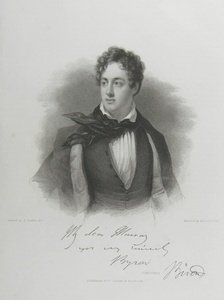| Method | Stipple and line engraving |
| Artist | Edward Finden after George Sanders |
| Published | A. Fullarton & Co. London & Edinburgh. [after 1834] |
| Dimensions | Image 125 x 118 mm, Sheet 257 x 165 mm |
| Notes |
Inscription reads: My dear Murray, yrs very sincerely, Byron sometimes Biron. George Gordon Byron, 6th Baron Byron (22nd January 1788 - 19th April 1824) was a celebrated British poet and leading figure of the British Romantic movement. A legend in his own lifetime throughout Europe, Byron was famous for his good looks and his brilliant, reckless personality. A poet of travel and romance, and a scintillating satirist, he lived abroad from 1816 in self-imposed exile and died of fever at Missolonghi where he had joined the Greeks in their fight for independence from Turkish rule. Byron's tragic demise placed the poet alongside his departed friends and fellow poets, Keats and Shelley, and secured his immortality with the British public. In the 1807-1809 painting of Byron, upon which this print was based, the poet is depicted alighting from a small boat on a dramatic rocky seashore. The figure behind him is usually identified as his servant Robert Rushton, and it is believed that the painting was commissioned by Byron to commemorate a journey to the Hebrides. The print captures the poet from the waist up, his cravat and outer coat blowing in the wind. The 'Murray' referred to in the inscription was Byron's publisher, and the plate for this print was originally prepared for Murray's 1834 edition of the Life and Works of Lord Byron. O'Donoghue 32, later state, printed by Fullarton Edward Francis Finden (1791-1857) was an English line and stipple engraver. Based in London, he mainly worked in collaboration with his older brother, the engraver William Finden (1787-1852). His separate works include a set of etchings for Richard Duppa's 'Miscellaneous Opinions and Observations on the Continent' (1825), and 'Illustrations of the Vaudois in a Series of Views' (1831). He was also a large contributor of illustrations to the annuals, books of beauty and poetry then in vogue. George Sanders, sometimes Saunders, (1774-1846) was a Scottish painter and miniaturist best known for his painting of Lord Byron, commissioned by the poet and now in the Royal Collection. Condition: Light time-toning to sheet, small water stain and tear to right margin not affecting image. |
| Framing | unmounted |
| Price | £40.00 |
| Stock ID | 36327 |

